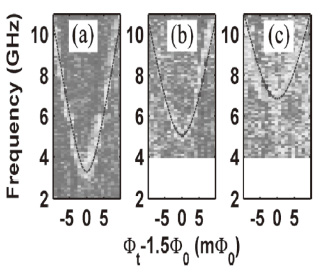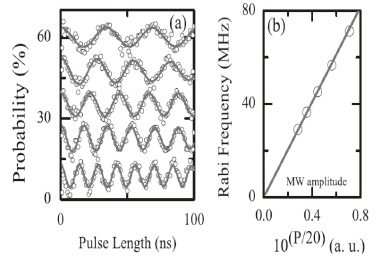Physical Science Laboratory
The flux qubit is one of the most promising candidates for constructing
quantum processors. An upgraded flux qubit, whose gap can be tuned in situ by two high bandwidth control lines, gives us two fundamental improvements:
"gap control" and "σx coupling". Based on these two fundamental improvements many possible applications can be realized, for example, realizing scalable qubus type multi qubits coupling and gate operations with large ON/OFF ratio[1] and σx coupling toward demonstration of quantum nondemolition measurement (QND) in solid state device [2].
Recently, we experimentally demonstrated the in situ tunability of the gap of a superconducting flux qubit, which was achieved
by replacing the smallest Josepshon junction of the qubit with a DC-SQUID.
By adding pulses via a local control line we can tune the gap over a range
of several GHz on a nanosecond time scale (Fig.1). The variation of the
persistent current and the gap with the control pulses is consistent with
the simulation.
Rabi oscillations between the ground state and the first excited state are a primary demonstration of a single qubit coherent operation. In Fig. 2(a), we show Rabi oscillations obtained at the degeneracy point. We set the voltage level of the two control lines to the degeneracy point of a dispersion relation, and varied the length of the microwave pulse resonant with the qubit, i.e., the gap frequency. After above sequence, the qubit state is measured by applying a measurement pulse. We repeated the whole sequence 2000 times to detect the relative occupation of the ground state and the excited state. We varied the amplitude of the microwave, and verified the linear dependence of the Rabi frequency on the microwave amplitude as shown in Fig. 2(b), which is a signature of the Rabi process [3].
[1] Y. D. Wang, A. Kemp, K. Semba, Phys. Rev. B 79 (2009) 024502.
[2] Y. D. Wang, X. Zhu, and C. Bruder, Phys. Rev. B 83 (2011) 134504.
[3] X. Zhu, A. Kemp, S. Saito, and K. Semba, Appl. Phys. Lett. 97 (2010) 102503.
 |
 |
|||||
|
|